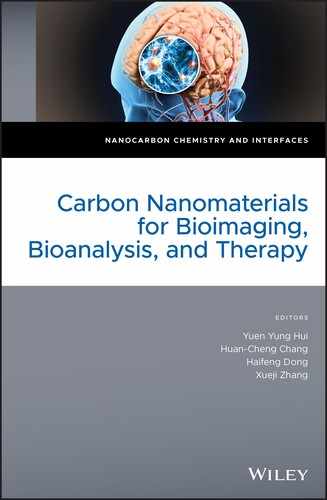Preface
Carbon nanomaterials have different shapes and structures, including carbon nanotubes, graphene, nanodiamonds, fullerenes, carbon nanodots, and carbon nanohorns, which have been widely applied for biomedical applications in the past few decades. However, not every carbon nanomaterial is promising for the respective applications. During the production of this book, we interviewed our chapter contributors to propose the best three carbon nanomaterials in their field of interest and share their valuable opinions here. It is interesting to find that carbon nanotubes, graphene, and nanodiamonds are the popular choices among our contributors. Their discussions about various biomedical applications of carbon nanomaterials can be found in the forthcoming chapters.
This book focuses on the application of carbon nanomaterial for bioimaging and bioanalysis. They form an important basis for modern diagnostics. Bioimaging can help us visualize biological structure and function at both microscopic and macroscopic levels. Imaging provides detailed information about biological structures. For instance, magnetic resonance imaging, X‐rays, radio imaging, ultrasound imaging, and optical imaging are now routinely applied for disease diagnosis. We are interested in fluorescence imaging, the most widely used optical method, because it offers resolution down to the submicrometer scale near the surface. (Carbon nanomaterials, such as nanodiamonds, have already been applied for super‐resolution imaging.) Furthermore, the combination of optical bioimaging with therapeutical approaches has inspired extensive studies to explore the biomedical applications of carbon nanomaterials.
On the other hand, carbon nanomaterials can be applicable for bioanalysis. Bioanalysis is a term derived in 1970 [1] that has traditionally described the chemical analysis of drugs in biological fluids. However, these analytical techniques and technologies cross many disciplines, such as forensic science and have already been applied to measure a wide range of biological molecules in biological fluids [ 1 ] . In this book, we discuss the application of carbon nanomaterial to analyze biological molecules, which will promote interdisciplinary research.
Structure of This Book
The purpose of this book is to provide background knowledge for entry into the biomedical applications of carbon nanomaterials. This book should be accessible to both advanced undergraduate students and graduate students. The intended audience is broad, including academic researchers, industry professionals, as well as instructors in biology, chemistry, physics, materials science, and other related areas.
The first part of this book is focused on the basic properties of carbon nanomaterials. Careful reading of Chapter 1 is important for newcomers who are not familiar with the structure of carbon nanomaterials. Chapter 2 describes the chemical functionalization of carbon nanomaterials. Chapter 3 gives an overview of the current technology in optical bioimaging and phototherapy. In Chapters 4–7 we apply carbon nanomaterials for bioimaging in different areas, high‐resolution imaging, infra‐red imaging, long‐term tracking, and photoacoustic imaging, respectively. Chapters 8 and 9 elaborate the applications of carbon nanomaterials for bioanalysis. Chapters 10–12 discuss the applications of carbon nanomaterials for therapy, especially phototherapy. Each chapter will propose the best three carbon nanomaterials in the field of interest. In this book, we highlight the latest developments and potential clinical translation of carbon‐based technologies for imaging and bioanalysis with the promise of improved therapeutic outcomes. Finally, we hope this book can guide our readers in exploring the world of carbon nanomaterials.
Reference
- 1 Hill, H. (2009). Development of bioanalysis. Bioanalysis 1 (1): 3–7.
